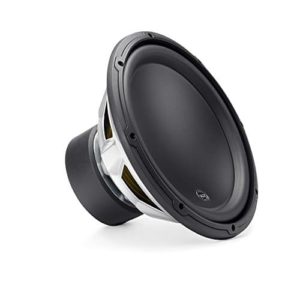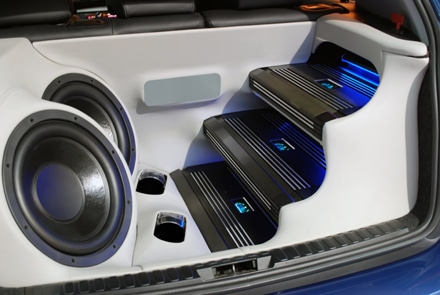
This post will explain how to select a subwoofer and/or a bass amp for your setup. I will cover a few different scenarios:
- You have a sub you want to use but need to find an amp for it.
- You have an amp you want to use but need to find a sub for it.
- You don’t have either and are looking to get both a sub and amp.
- You will be adding speakers and a sub and want to find a single amp to power them all.
1. You have a sub you want to use but need to find an amp for it.
If you already have a sub you want to use or want the same sub as a friend, etc. then you need to find out the specs of the sub. You can usually find these on the box or manufacturers website or a website that sells products (soon to be this one) like Sonic Electronix or Amazon.
What you are looking for in these specs is the RMS (root mean squared, or continuous) power rating, how many voice coils your sub has, and the impedance (ohms). Many subs will have a power rating listed that is max power. This is not what you are looking for when selecting an amp. Your sub and amp will spend most of its time at RMS, not peak power.
Once you find these specs, you need to find an amp with the same (or similar) RMS rating at the impedance your sub is. You can get a more or less powerful amp, but with less power your sub won’t hit as hard. And with more power, you risk overpowering your sub if you don’t tune the amp right (more on that later).
In both of these cases, you run the risk of blowing you sub. If underpowered, you will likely try to turn the gain on the amp up to get the most out of it. This sends a clipped signal to the speaker and can fry the voice coil(s). If overpowered, the speaker tries to play past its max excursion which can break or tear the voice coil, spider, or surround and ruin the sub. Here is a great article explaining this on Crutchfield.
So, it is best to find an amp with a similar RMS rating to your sub. This can be more difficult when going with cheaper brands, though, as they tend to overrate everything. It’s hard to say with these without testing, but if you go with a CEA compliant amp and sub, you know you will be close in ratings.
Here’s an example:

Say you have a 4 ohm single voice coil JL 12W3V3 sub ($240 with free shipping on Amazon) with an RMS power rating of 500 watts. Now JL also has a recommended power range for this sub of 150-500 watts RMS. This means any amp with an RMS rating between 150-500 watts at 4 ohm will work fine with this sub. But we’ll assume you want to get the most out of it, so we’ll look for a CEA compliant amp that puts out 500 watts RMS at 4 ohms.
[amazon asin=B0035VQ5BY&template=add to cart]

Would you look at that! Sonic Electronix has a whole list of CEA Compliant amps. If you are just looking to power a sub, a monoblock amp will be what you are looking for. You can also use a 2 channel amp and bridge the channels, but doing that you can usually only run a 4 ohm sub (which is fine for this situation, but if you add more subs or have a 2 ohm sub may not work – more on this later). So I’m just going to go down the list and find the first 500 watt at 4 ohm CEA compliant amp I see: the Pioneer GM-D9601 ($165 on Amazon with prime shipping).[amazon asin=B00CLFM596&template=add to cart]
Of course if you are set on a different brand or lower price or smaller amp you can sort through and find something else, but that’s it! You’ve found an amp for your sub.
Note: For a dual voice coil sub, the impedance will not be what to look for on the amp. If you have a dual 2 ohm sub, you can either run it at 1 ohm or 4 ohms. If you have a dual 4 ohm sub, you can run it at 2 or 8 ohms. When you add more than one sub, this changes, but there will be more on this later if you are confused.
2. You have an amp you want to use but need to find a sub for it.
This is going to be very similar to scenario number 1, so please read that and I’ll explain the differences here.
So this time you are going to look at the specs on your amp: RMS power at different ohm loads. In the first section you have to match the sub’s impedance with an amp, but in this section you have an amp that can probably handle different impedances. This gives you a little more selection on what sub to get.
If you have a monoblock amp, it may be stable all the way down to 1 ohm (usually 2 ohms, though). If you have a 2 channel amp you plan on bridging, it will probably only be stable down to 4 ohms, though some are stable down to 2 ohms. So find out what ohm sub you want to go with.
Here’s an example:

Assume you have a Kenwood KAC-5001PS ($112 on Amazon with Prime shipping). This amp can put out 500 watts RMS at 2 ohms or 300 watts RMS at 4 ohms. In this case a 2 ohm sub will be louder, so let’s go with that. Now check Sonic Electronic’s (or others’) list of CEA compliant subs. We’ll be looking for a 2 ohm sub rated at 500 watts RMS, or a dual 4 ohm sub rated at 500 watts RMS (see the note above).[amazon asin=B00B8B0Q9A&template=add to cart]

The first one I see on the list is the Alpine SWS-15D4 – 15″ dual 4 ohm sub ($120 on Amazon with free shipping) rated at 500 watts RMS. This can be wired to 2 ohm and get the 500 watts RMS from your amp.[amazon asin=B0081JFX8G&template=add to cart]
There you go. That’s all you need to do to find a sub for your amp.
3. You don’t have either and are looking to get both a sub and amp.
For this one you will simply combine steps 1 and 2 from above, but this can be tricky since there are endless possibilities. You may have a certain budget you are shooting for, or you may have a certain brand you definitely want or don’t want to go with. The best thing to do in this situation is listen to other people’s setups and find one that is right for you and go with a similar setup.
You could also just randomly pick something. Say there is a nice name brand sub or amp on sale, so you get it. Then just go to the section above to find out how to pick the other.
Maybe you think a certain power range sounds good, so you randomly pick 500 watts RMS. Then go find a good 500 watt sub and 500 watt amp.
Once again, there are endless possibilities here, so it is best to read the above sections to get the gist of it.
4. You will be adding speakers and a sub and want to find a single amp to power them all.
For this section, you may already have the speakers and sub you want to use, or maybe just the amp you want to use. In any case, read the above sections to learn how to match power ratings of amps and subs. Matching speakers and amps is coming soon, but is the same thing as matching single voice coil subs with their respective amps for sake of argument.
To use one amp to power all your speakers and your sub, you can use several different setups:
- 4 channel amp
- 5 channel amp
- 6 channel amp
4 Channel Amp
For this setup, you can either run just your front speakers off the first 2 channels and bridge the rears to power your sub(s) or wire the front and rear speakers on the left together and front and rear speakers on the right together to run on channels 1 and 2 and bridge the rear to power your sub.
Either way, to power a sub and speakers with a 4 channel amp, your sub will be powered by bridging two of the channels on the amp. So in this situation, you will need to find the output ratings for the amp when 2 channels are bridged and match a sub to that or vice versa.
5 Channel Amp
A 5 channel amp will have 4 channels for speakers and a single mono channel specifically for a sub. In this case you will need to match the speaker channels to speakers with the right rating (more on that later but pretty much the same thing as matching subs with amps) and match the sub channel with a sub with the right rating. This is exactly the same as sections 1 and 2 above when matching subs to a monoblock amp. The only difference is you have 4 other channels to power speakers.
6 Channel Amp
This is the same as the 4 channel amp situation, but instead of having 2 speaker channels and 2 of them bridged to your subs, you will have 4 speaker channels and 2 of them bridged to your sub.
Well there you have it. Now you can go find the right sub or amp for your setup. If you still have questions, let me know in the comments or send me an email.

Can I pair a Kenwood KAC-501 1000w mono amp to a kenwood set of bp-210s?
Sorry for the late response. Are you talking about this amp: https://www.bestbuy.com/site/kenwood-kac-1000w-class-d-digital-mono-mosfet-amplifier-with-variable-low-pass-crossover-black-dark-silver/5577926.p?skuId=5577926 and these subs: https://www.crutchfield.com/S-6oSjenl2jet/p_113BP210/Kenwood-BP-210.html ?
If so, you can pair those together, but you will need to carefully set the gain. That amp will put out way too much power for the subs depending on what impedance they are wired to. Do you already have both of these and that’s why you’re asking?
Actually, they may go together pretty well depending on what website is correct. Crutchfield says the subs are rated at 100W RMS. Another website said 600W max, so probably somewhere in between there, and that amp is supposed to put out 300W RMS at 4 ohm. I wouldn’t think you would have any problems with this setup, but still be sure to set the gain properly
Guys I’m honestly loving the content on this site, Great info, thanks for sharing!
Thank you sir. Thanks for looking. Let me know if you have any questions
Love the concise article! Thanks